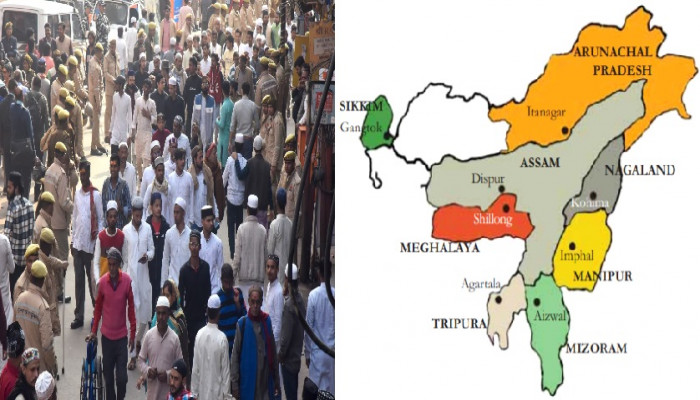Rising Muslim Demographics in India's Northeast
- In Current Affairs
- 03:11 PM, Oct 14, 2025
- Ankita Dutta
Assam Chief Minister Dr. Himanta Biswa Sarma recently predicted that the population of Bangladeshi Muslims (often referred to as Miya in local Assamese parlance) in Assam is likely to rise to 38 per cent in the upcoming Census, up from about 34 per cent in 2011. While claiming that the Muslim population is increasing in the state due to “infiltration” rather than natural growth among local Muslims, he noted that this increase could make Muslims the largest community in Assam in terms of numerical strength. He further stated that districts like Majuli, the heart of Assamese Vaishnavite culture and traditions, have experienced 100 per cent growth in their Muslim population. What is most concerning is that the Muslim population in the state is growing significantly; however, Hindus now account for only 40 per cent of the state’s total population, as claimed by the Hon’ble Chief Minister himself. It is true that Assam has undergone a marked shift in its population composition over the years, especially after 1985, i.e., following the signing of the Assam Accord.
Despite the BSF guarding India’s borders with Bangladesh, the unchecked influx of illegal immigrants has completely altered the demographic profile in several border districts of Assam, leading to an unnatural increase in the total population of the state. The demography of many districts has been transformed without war within a time span of hardly two generations. This is nothing but a planned aggression against the Assamese people by Bangladeshi Islamists via committing crimes such as rape and molestation against Assamese Hindu women, or converting them into Islam on the pretext of marriage and sometimes even force-feeding them beef; stealing property; cutting crops from fields owned by native Assamese and destroying the fishes in their ponds and fisheries; destroying the dairy farming industry through systematic stealing of cattle and other milch animals; trapping youngsters into drugs and alcohol; forcible occupation of lands; desecration of Hindu temples, Sattras and Namghars, and even killing the religious heads of these institutions; human trafficking, prostitution and AIDS
However, the problem is certainly not confined to Assam alone, especially in the context of the North-East. Illegal immigration has been going on in other states of the region, too, on a large scale. Besides the Kuki-Zo people from Myanmar, Bangladeshi and Rohingya Muslims have infiltrated into different parts of the North-East, especially Mizoram, where they are working as both skilled and unskilled labourers. In Manipur, there has been a sudden increase in the number of people who cannot speak or understand a single Manipuri word but move around freely in many parts of the state. Immigrant Muslims, mostly illegal Bangladeshis and Rohingyas, fraternise in vast numbers with the Pangals (local Muslims) in several regions of the Valley districts of Manipur, especially Kakching, Thoubal, Bishnupur, Imphal East and Imphal West. They have even married, bought lands and settled in the state. For instance, at a place called Lilong in Thoubal district, a significant number of Muslim immigrants have entered into marital alliances with local Muslim girls and settled there.
After Manipur and Mizoram, Arunachal Pradesh is on the target of Bangladeshi Muslims, primarily because of its fairly low population density and abundant availability of land. Frequent reports can be heard in the local press of the ouster of these immigrants and their subsequent influx into Assam. One cannot ignore the fact that Bangladeshi infiltrators have been caught in several interior areas of Arunachal Pradesh, known for their not-so-easy accessibility. Sometimes back, a video of a Bangladeshi Muslim man named Mohammad Irfan Qureshi claiming himself to be from Tinsukia district in Assam, had gone viral on social media. Married to an Arunachali woman working in remote Palin town of Kra Daadi district in the state, he could be seen giving a media briefing just a few days after defaming his employer, Tarh Maying, a local Arunachali. He raised serious allegations of physical assault and non-payment of wages against Maying. However, in a major turnaround, Qureshi later retracted his statements, admitting that the accusations were false and made intentionally to get rid of his owner (https://www.facebook.com/100084048587018/videos/reality-checked-i-lied-to-get-rid-of-my-owner-mohammad-irfan-qureshi-retracts-al/1404458487339232/)
It is to be noted that the dislike of the native youth for manual labour, especially agricultural activities, has been a major factor behind the influx of illegal immigrants in states like Assam. The same holds true for other states too, Nagaland in particular, one of Assam’s neighbouring states. Lack of active interest of the local Naga people to work in the agricultural fields eventually paved the way for non-locals, Bangladeshi Muslims in particular, primarily in sectors like tilling and ploughing. Gradually, Nagas became increasingly dependent upon their cheap services. But how could illegal Bangladeshi Muslim immigrants establish their foothold in a state like Nagaland that does not even have a border with Bangladesh, and despite the system of Inner Line Permit (ILP) in operation? It is a significant question in this regard. Similar to Arunachal Pradesh, frequent reports of the ouster of Bangladeshi Muslim immigrants and their entry into Assam have been periodically coming from Nagaland as well.
Way back in 2003, Neiphiu Rio, the Chief Minister of Nagaland, had accused the Government of Assam, led by former Chief Minister Shri. Tarun Gogoi of exporting illegal immigrants into Nagaland, and that Nagaland cannot take any action against them, for they were already in possession of valid identity documents procured fraudulently in Assam. Muslims adopted an ingenious strategy of marrying local Naga girls, with the sole purpose of integrating themselves with the indigenous Naga population and claiming ownership of land, one of the most prestigious assets of the Nagas. Over a period of time, it resulted in the emergence of a hybrid race, often referred to as Nagamia. For instance, if the wife-cum-mother is a Sumi Naga and the husband-cum-father a Muslim, then their offspring are commonly classified as Sumiya or Semiya. Likewise, Aomia (wife = Ao Naga; husband = Muslim), Zeliangmia (wife = Zeliangrong Naga; husband = Muslim), Angamia (wife = Angami Naga; husband = Muslim), among others are considered as separate sub-races, thereby silently changing the state’s demographic pattern.
It may be mentioned here that Nagaland recorded the highest rate of population growth in India, from 56.08 per cent during the period 1981-1991, to 64.41 per cent during 1991-2001. Interestingly, this growth rate has not been uniform throughout the state. An extremely high growth rate has been recorded in only two districts of the state bordering Assam, i.e. Dimapur and Wokha. It is significant to note that Wokha recorded a population growth rate of 95.01 per cent during the period between 1991 and 2001, this being the highest rate of decadal growth district-wise in the country. A section of the Naga society has long been viewing this as a threat to their distinct tribal identity. At present, immigrant Muslims of Bangladeshi origin have been able to make a tremendous impact in the trading sector of Nagaland, usurping a major chunk of the labour in the state’s businesses and the construction sector in particular, which has harboured the highest number of immigrant labourers.
On any Islamic religious day, such as Id and Muharram, at least more than half the shops in Kohima, Nagaland’s capital, and Dimapur too, remain closed. All construction activities come to a halt. This is nothing but a clear indication of the hold exercised by the Bangladeshi Muslim immigrant community on trading and commercial activities in the region, much to the detriment of national interests. The scenario in Meghalaya, too, is not any different. Meghalaya shares a 443-km border with Bangladesh, part of which is porous, hilly, unfenced and prone to frequent infiltration. The main factors responsible for the influx of Bangladeshi nationals to Meghalaya are the high demand for cheap labour in coal mining areas, manual jobs, and porous and poor security along the border. Resultantly, illegal labourers of immigrant stock have flocked in large numbers to the mining activities in the coal and limestone mines of Meghalaya, which local tribesmen do not dare enter. Although exact figures are not available anywhere, occasional reports of violent clashes between immigrants and locals have poured in.
In September 2025, the Meghalaya Police had busted an international racket involved in smuggling stolen two-wheelers from India to Bangladesh, arresting 17 persons, including nine Bangladesh nationals, during a series of operations, dealing a major blow to the cross-border network engaged in stealing, transporting, and handing over two-wheelers across the Indo-Bangladesh border. There have been reports of Bangladeshi infiltrators walking through the hilly terrain after crossing broken fences and entering India through the border between Assam and Meghalaya. The fact remains that several patches of the border with Bangladesh in the Meghalaya sector are still unfenced. Some land owners in the state have reportedly approached the courts as they are unwilling to part with their land for erecting fences. Coupled with the unfenced border, the terrain is quite challenging with hills and forests. Hence, Bangladeshi infiltrators find it relatively easier to sneak in through Meghalaya.
However, we need to understand that in states like Meghalaya, Nagaland, or Mizoram, ‘outsiders’ or ‘non-tribal’ individuals, including Bangladeshi immigrants, cannot purchase or own land, especially in areas falling under the Sixth Schedule of the Indian Constitution, which grants special protection to tribal areas. This implies that the Constitution supports such measures, recognising the unique status and rights of tribal communities in certain regions of the country. In Meghalaya, for example, the Land Transfer (Regulation) Act, 1971, enacted by the Meghalaya Government, protects the indigenous Khasi, Jaintia, and Garo communities by restricting land ownership for non-tribals and outsiders. The primary reason is to safeguard the lands and cultural identity of the native people from outside encroachment. Not just that, almost 80 per cent of jobs in the state are reserved for the indigenous tribals (Khasi, Jaintia, Garo, Hajong, Koch). The logic is that tribals are a small minority in this country, and their rights over land, resources, and employment must be protected from the larger non-tribal population.
Much of Meghalaya, including popular tourist destinations like Shillong, falls under the Sixth Schedule of the Constitution. So, the immigrants cross over to Assam and other parts of the country. Similar patterns of land encroachment by Bangladeshi immigrants are evident in Tripura and other parts of the North-East, like Dimapur in Nagaland, or Lilong in Manipur. Nevertheless, the massive demographic shifts witnessed in Assam due to illegal immigration from Bangladesh are incomparable to those of any other. The primary target of the immigrants has always been Government lands and properties of indigenous/native residents. Many of the state’s indigenous tribes have already faced land alienation due to settler influxes. In recent times, many cities of India too are experiencing such shifts in population. The examples of Devabhoomi Uttarakhand and Himachal Pradesh are cases in point. While the scale and context may vary, the mechanisms – political patronage, forged documentation, and intimidation – all mirror Assam’s experience, signalling a broader challenge for the State in the times ahead.
References:
- Hiranya Kumar Bhattacharyya, Operation Lebensraum, Bloomsbury: India, 2018.
- Assam Muslim population growing due to ‘infiltration’: Himanta Sarma, Madhyamam, October 12, 2025. https://madhyamamonline.com/india/assam-muslim-population-growing-due-to-infiltration-himanta-sarma-1456507
- Census of India, 2001 and 2011. https://censusindia.gov.in/census.website/
- Seven illegal Bangladeshi migrants held in Meghalaya, The Assam Tribune, September 15, 2010. https://assamtribune.com/seven-illegal-bangladeshi-migrants-held-in-meghalaya
- Bongaigaon crackdown fallout: BSF denies infiltration claims through Meghalaya, The Assam Tribune, July 24, 2025. https://assamtribune.com/north-east/bongaigaon-crackdown-fallout-bsf-denies-infiltration-claims-through-meghalaya-border-1585954
- Int'l bike smuggling racket busted in Meghalaya, Bangladesh nationals among 17 held, The Assam Tribune, September 7, 2025. https://assamtribune.com/north-east/intl-bike-smuggling-racket-busted-in-meghalaya-bangladesh-nationals-among-17-held-1590505
Disclaimer: The opinions expressed within this article are the personal opinions of the author. MyIndMakers is not responsible for the accuracy, completeness, suitability, or validity of any information on this article. All information is provided on an as-is basis. The information, facts or opinions appearing in the article do not reflect the views of MyindMakers and it does not assume any responsibility or liability for the same.







Comments